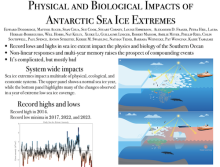Impacts of recent Antarctic Sea-Ice Extremes
Will
Hobbs
Australian Antarctic Program Partnership (AAPP)
Poster
Antarctic sea ice has experienced five extreme events in the last decade: three record lows, and two record highs. These extreme sea ice events have wide ranging impacts on the ocean, other cryospheric components, and the Southern Ocean ecosystem as well as far field repercussions. Extreme low summer sea ice results in an increased loss of multiyear fastice, increases in coastal exposure and changes the seasonality of the sea-ice cycle. Surface ocean warming during the summer is observed due to the ice-albedo feedback, resulting in changes to the rate of watermass transformation. We find that ice-shelf calving is correlated with sea-ice area, so that years with less sea ice show increased calving. Within the annual cycle, prolonged open water affects the seasonality of surface phytoplankton blooms. In addition, changes to the sea-ice seasonal cycle alter the input of iron from melting sea ice, subsequently modifying primary productivity. Under-ice algae are strongly affected by changes to the sea-ice coverage, and years with less ice show substantially reduced under-ice primary productivity. The impacts on higher trophic levels are complex, but include habitat loss and impacts on prey availability. The loss of coastal fast ice in the summertime causes logistical challenges for Antarctic fieldwork and resupply missions for Antarctic research stations. Changes in the sea-ice and fast-ice seasonality as well as in the physical properties of the ice have profound effects on coastal and ice-infested water operations, requiring increased observations and analysis of the ice conditions. Changing accessibility of the Southern Ocean may lead to renewed tensions around Antarctic treaty negotiations. Understanding the full impacts of recent, and future, sea ice extremes requires a broad observational network that spans the physical and ecological systems of Antarctica and the Southern Ocean.

hobbs-will-polar-poster.pdf
(5.54 MB)
